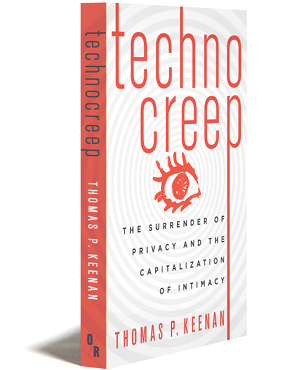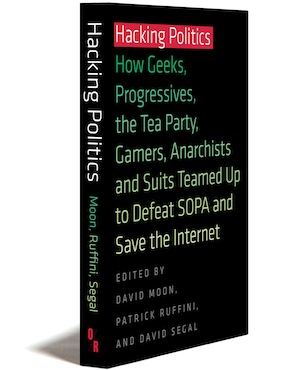Technocreep
The Surrender of Privacy and the Capitalization of Intimacy
“In Technocreep, Dr. Keenan explores some of the most troublesome privacy-invasive scenarios encountered on the web and offers users a number of excellent, practical ideas on how best to protect their privacy and identity online.” —Dr. Ann Cavoukian, Information and Privacy Commissioner of Ontario
“Keenan’s vivid explanation of the perils of creepy technologies is both hilarious and terrifying. A great read for those who build systems and an entertaining excursion for anyone who wants to peek under the covers of technology.” —Dr. Cullen Jennings, Cisco Fellow
“Thomas P. Keenan has done a wonderful job in threading seemingly disparate ideas into the single notion of 'creep.' This book gives numerous pithy examples of how we arrived at where we are, and where we might be headed.” —Dr. Peter G. Neumann, Senior Principal Scientist in the Computer Science Laboratory at SRI International, ACM Risks Forum moderator
TweetBuy This Book
|
Paperback: $18/£12
|
E-book: $10/£7
|
Print + E-book: $24/£15
|
Buy with Bitcoin
Bitcoin is an international, decentralized digital currency. Learn more at bitcoin.org.
Print: $18 Bitcoin 
|
E-book: $10 
|
Print + E-book: $24 
|
About the Book
“Technology is rapidly moving into our bodies,” writes cyber expert Keenan, “and this book gives a chilling look ahead into where that road may lead us – on a one way trip to the total surrender of privacy and the commoditization of intimacy.” Here is the definitive dissection of privacy-eroding and life-invading technologies, coming at you from governments, corporations, and the person next door.
Take, for example, the furor over “Girls Around Me”: a Russian-made iPhone App that allowed anyone to scan the immediate vicinity for girls and women who checked in on Foursquare and had poorly secured Facebook profiles. It combined this information in a way never intended by the original poster. Going to a Disney theme park? Your creepy new “MagicBand” will alert Minnie Mouse that you’re on the way and she’ll know your kid’s name when you approach her. Thinking about sending your DNA off to Ancestry.com for some “genetic genealogy”? Perhaps you should think again: your genetic information could be used against you.
One of the world’s top computer security experts, Keenan helped the Canadian government write its computer crime laws in 1983, and co-wrote the award-winning CBC series on cybercrime, “Crimes of the Future.” In 2013, he won the Natural Sciences and Engineering Research Council’s annual award for science promotion.
Includes a special chapter on how to “de-creep” your digital profile: how to throw governments and corporations off your cyberscent!
Publication August 2014 • 224 pages
Paperback ISBN 978-1-939293-40-4 • E-book ISBN 978-1-939293-41-1
About the Author

Photograph © Riley Brandt/University of Calgary
|
A Fellow of the Canadian Defence and Foreign Affairs Institute, Thomas P. Keenan is a frequent contributor to CBC Radio and Television. He writes a men’s health column for the Postmedia newspaper chain and is National Technology Correspondent for Business Edge News Magazine. At the University of Calgary, he is Professor of Environmental Design and Adjunct Professor of Computer Science. |
Read an Excerpt
Image Creep
I saw Google Glass before it was even a twinkle in Eric Schmidt’s eye.
As a technology writer and reviewer, I was sent demo versions of all sorts of products, including some that never made it to market. In the mid 1980s, a package arrived with one of the first heads up television displays aimed at the consumer market. It was set of glasses with a tiny monitor and a prism that allowed you to watch TV while still participating in normal life.
The device, now consigned to the tech dustbin, did give me one moment of profound technocreepiness. I was testing it one night in my university office, using it to watch Sixty Minutes. The cleaning lady came in to empty the trash. I will never forget what happened next. I saw a chimera—an elderly lady’s body with Mike Wallace’s head grafted on top. I screamed. She screamed. It seemed like a dumb way to watch TV, so I sent the thing back and wrote a lukewarm review: it was also extremely uncomfortable to wear.
The introduction of Google Glass has brought this type of technology literally to the public’s eye. All of sudden, people are walking around with a device that enhances their ability to grab information out of the ether. Google Glass wearers can potentially recognize your face as they shake your hand, and then casually glance upwards to retrieve your kids’ names and birthdays.
But what really alarms many is that Google Glass can also secretly take a picture, or record a video, and immediately upload it to the Internet, just by the wink of an eye or the raising of an eyebrow. Google Glass does have a light to indicate when it is taking a photo or recording video. People promptly found ways to subvert it.
Chris Barrett, one of earliest users of Google Glass, said he was having trouble using the device in bright sunlight. So he designed a clip-on sunshade, a piece of plastic that can be run off on a 3D printer. He has even made the code for it freely available online. In addition to blocking the sun, Barrett’s creation happens to cover that pesky light that tells others you are recording them.
Barrett loves wearing his high tech eyewear in places it is not supposed to go. He has reportedly filmed inside an Atlantic City casino and, in a stroke of luck, apparently became the first person to record an arrest with Google Glass. This little documentary was quickly posted to YouTube.
Dozens of innocent bystanders, some of them children, appear in that video, and many are facing the camera. Coupled with massive facial image databanks, and advances in facial recognition software, they could probably be identified. A bizarre new social rule is emerging: if you are really trying to protect your privacy, you should stay away from arrests, car accidents, riots, and landmarks — anything that people are likely to photograph. Perhaps you should not go out at all.
The camera function of Google Glass and similar devices is really a giant social experiment to re-define where photography is acceptable and what behaviors will get you called a creepy “glasshole,” a cheeky term that even Google has started using. Even in a public place, where photos are generally fair game, people have reported being very disturbed by strangers taking their photos; especially pictures of their children.
….Internet Rule 34 (“If it exists, there’s porn of it”) strikes here with vengeance. Soon after Google Glass became available, the “first Google Glass porn” appeared online at the adult app store mikandi.com. Their inaugural offering features a cameo appearance by Ron Jeremy, holder of the Guinness Book of World Records title for “Most Appearances in Adult Films.” Now a senior citizen, he keeps all his clothes on in this short piece of point-of-view pornography. A censored version is available on YouTube.
There seem to be no limits to human stupidity when it comes to posting inappropriate images online. People have distributed photos of themselves in an unbuttoned airline stewardess uniform (Ellen Simonetti, the “Queen of the Sky” blogger who flew for Delta airlines) and taking a bath in the sink at Burger King (Timothy Tackett). Both were fired from their jobs, though they went on to other careers, propelled no doubt by the notoriety from their online misadventures.
Simonetti and Tackett are consenting adults, but things are quite different when children are involved. Often they seem either unaware of, or unconcerned about the risks of releasing questionable comments and images into the Wild West of cyberspace. In a CNN report called “The secret life of my sixth grader,” a mother creeps herself out by spying on the texts and Instagram photos of her eleven-year old son, who, she notes, “has never let on that he is remotely interested in girls.” The content of his messages and photographs soon convinces her otherwise. “Maybe it’s the digital photo-filters,” she muses, “but the girls seem sexy beyond their years.”
….Bare skin-finding technology works both ways, of course, and there are now apps that will mine photos posted online specifically for nudity or some close approximation. As just one example, Badabing!, available in the iTunes stores, claims it will save you the effort of browsing “endlessly through a friend’s albums looking for beach or pool pictures.” The developers call it “the only image social recognition app,” but it certainly won’t hold that title for long.
The wildly popular smartphone app Snapchat would appear to address the problem of persistent photos, since images sent through it disappear within a few seconds. However, this may well be a false sense of security. Armed with the right forensic tools, experts have been able to mine smartphones for supposedly deleted Snapchat photos. There are also apps like SnapSave and SnapChat Save Pics that are explicitly designed to defeat the ephemeral aspect of Snapchat photos and videos. These apps work around the Snapchat system, so, as one says, “the sender of the snaps doesn’t get notified” that you are not playing by the rules.
Even without these apps, someone can always point a camera or another smartphone at a fleeting Snapchat image and capture it for posterity. Just assume that if you send a photo, it can be grabbed and have a life that extends far beyond momentary ogling.
Increasingly, your face is becoming a key that unlocks a vast amount of personal information about you. This was brought to the public’s attention when some users of a leading U.S. matchmaking site learned that their online personas were not as private as they thought they were.
Dating site users almost always include a photo, but typically register using a pseudonym, like sexybaby235 or hungguy404. The would-be lovers only reveal their true identity when someone of interest comes along. Carnegie Mellon University professor Alessandro Acquisti grabbed almost six thousand dating site profiles from Match.com and compared them against publicly available Facebook profile photos in the same geographical area using a facial recognition program called PittPatt. His goal was to “de-anonymize” people.
He immediately encountered an interesting research problem: just because the computer says two faces match up does not mean it is true. The human brain is still the world’s best facial recognition engine, so Acquisti enlisted human reviewers to rate the computer’s work. Amazon runs a business called Mechanical Turk. Its name pays homage to the mysterious chess-playing robot constructed in Europe in the late 18th century that secretly contained a chess-playing human being. Amazon’s system is a high tech “piecework environment” where people agree to do menial tasks, like looking up a company’s main office address, for a few pennies each. If you do enough of these, fast enough, you can actually earn some decent cash.
The researchers asked the Mechanical Turk validators to sort the computer’s proposed facial matches into categories like “sure match” and “highly likely.” Acquisti’s conclusion was that “about 1 out of 10 dating site’s pseudonymous members is identifiable.”
In the Media
The Current, November 6th 2014
Public Books, November 1st 2014
The Daily Californian, September 8th 2014
The Matthew Filipowicz Show, August 12th 2014
Psychology Today, August 11th 2014
Counterpunch, July 25th 2014
Prague Post, July 14th 2014
ZDNet, June 20th 2014
CBC, May 23rd 2014
CNN, May 16th 2014
Tencer & Grose (630 CHED), April 30th 2014
Canada.com, November 8th 2013





